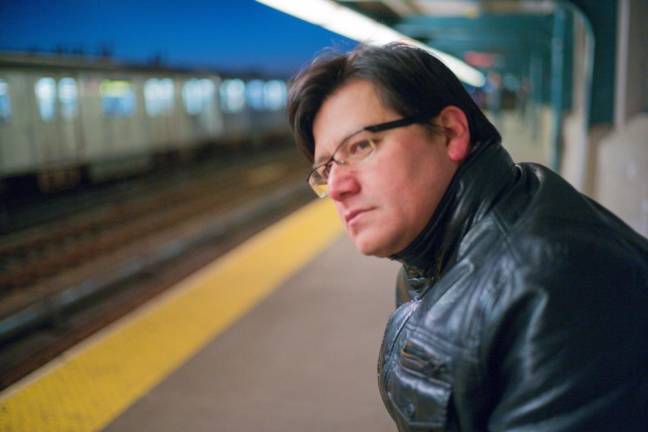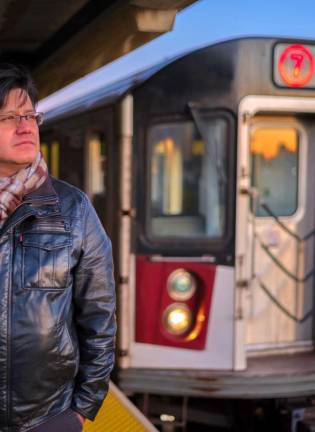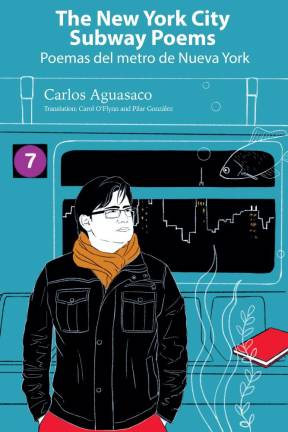‘The Process of Becoming a New Yorker’
Poet Carlos Aguasaco’s journey from Colombia to riding the subway in pre-COVID NYC



Colombian poet Carlos Aguasaco, associate professor of Latin American Cultural Studies at The City College of New York, is the first author of color to be published by the Ohio-based Ashland Poetry Press for his bilingual book of poems titled “The New York City Subway Poems.” He is also the editor of Artepoética Press Inc., a New York City based Hispanic publishing house, and the organizer and curator of The Americas Poetry Festival of New York. Aguasaco has authored six books of poetry.
His recent book of poetry gives a voice to the immigrant experience and the process of moving to New York City from Bogotá, Colombia. It was written pre-COVID, and although NYC has reopened, the book is reminiscent of a time when bustling New York was “normal.”
What inspired you to write “The New York City Subway Poems”?
I wrote many of these poems on the 7 train line. It’s a book about immigration and the process of coming to be in another country — in another city. I began writing the first poems 20 years ago when I was living in Richmond Hill, and actually the very first poem of the book is written in Richmond Hill commuting and trying to get to know New York by writing either on the J train or the E train to Manhattan. And the poems about New York, are the poems about someone who’s coming to the city and trying to be in this new context, so that’s why I began writing them.
I attended City College for my master’s degree. I was working on Convent Avenue and 135th Street. So, the commute was long and I spent most of the time trying to read ... trying to read in another language because when I came to this country, I spoke no English at all.
It took me awhile to get acquainted and to find a way to establish communication. It came as a natural development of someone who becomes a New York City subway rider. It’s important to note that I come from Bogotá and there are no subways in Bogotá, so it was a new experience for me. And it’s also a process of becoming a New Yorker. You know how New Yorkers are: they are always in a rush; always going somewhere; they mind their own business with the exception of 9/11. That was the one day when people look at each other in the eyes; that was the one day I remember people actually crying and looking at each other in the eyes. It’s a memory that I carry with me but beyond that day riding the subway became a ritual for me.
How did you create these NYC subway poems?
Since I had a long commute, I did a lot of reading for my master’s degree, and I also composed the poems by looking at people and thinking about the journeys of the immigrant. The title of the book,” The New York City Subway Poems,” is also an homage to García Lorca, the Spanish poet who lived in New York and wrote a book of poetry in New York at the beginning of the 20th century.
Many years later, when I was a doctoral candidate in New York, I went to Mexico. I realized Mexico was going through the same experience, so I wrote a book about the violence against women in Mexico in the border — in Ciudad Juárez. And I wrote about this narco-violence and the situation in Mexico that had a lot to do with the immigrant experience in New York.
I don’t usually write on-site, but what happens to me is that I travel and it takes me awhile to compose the poems. I’ve been traveling lately and have visited a little bit more than 20 countries as a writer. All the experiences that I gather abroad, I would bring to my writing in the subway, and I would compose the poems there.
I have a technique, which is I compose every line in my memory — my mind, and when the poem is ready I sit down and transcribe it. The train has, especially in Queens, over 175 different languages being spoken. Composing these poems, I’ve shown first, the process of adaptation and of becoming, and then a more settled New Yorker like experience of someone who’s concerned about the social issues that are affecting us like homelessness and what Raymond Williams calls the “structure of feeling,” which is the way we experience history.
As a Latino, how do you feel being the first person of color to be published by The Ashland Poetry Press?
The countries that I have called home are the ones that have been more reluctant to publish my work. I have an editor in Mexico. I have an editor in Spain. I have an editor in Ecuador. But I never had an editor in the United States, and I’ve never had an editor in Colombia. But then Ashland Poetry Press approached me with this idea. My editor convinced the publishing house to open a translation series after 51 years.
I do believe this is a step in the right direction. This is a step into what we need to be at a time when we are living in this world of bigotry, of hate. A publishing house that decides to step away from their own grounds and reach out to New York and publish a bilingual edition of my book and give me my first opportunity in the United States with this collection, and give themselves their first opportunity bringing new immigrant voices to their collection. I was glad to say yes, and that the editor was fantastic. And the next author is also a New Yorker of color, an African American writer. They are changing, but they are changing for good.
This interview has been edited and condensed.
Ashley Arocho is a NYC native and does public relations for The City College of New York.